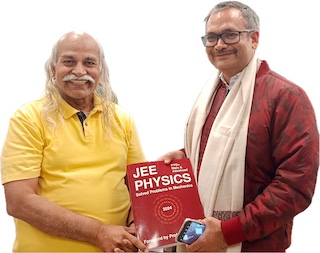Isothermal and Adiabatic Processes
Properties of an Isothermal Process
- The temperature T of the system is constant.
- The equation of state is $pV$ = constant.
- The work done by n moles of an ideal gas in an isothermal expansion from volume V1 to V2 at temperature T is given by \begin{align} W=nRT\ln\frac{V_2}{V_1} \end{align}
- The change in internal energy is zero i.e., $\Delta U=0$.
- The heat supplied to the gas is equal to the work done by the gas.
Properties of an Adiabatic Process
- The heat supplied to (or from) the system is zero i.e., $\Delta Q=0$.
- The equation of state is $pV^\gamma$ = constant.
- The work done by n moles of an ideal gas in an adiabatic expansion from volume V1 to V2 at temperature T is given by \begin{align} W=\frac{p_1V_1-p_2V_2}{\gamma-1} \end{align}
- By first law of thermodynamics, $\Delta U=-\Delta W$. The temperature of the gas decreases (i.e., $\Delta U < 0$) if work is done by the gas.
Solved Problems from IIT JEE
Problem from IIT JEE 2011
5.6 litre of helium gas at STP is adiabatically compressed to 0.7 litre. Taking the initial temperature to be $T_1$, the work done in the process is,
- $\frac{9}{8}RT_{1}$
- $\frac{3}{2}RT_{1}$
- $\frac{15}{8}RT_{1}$
- $\frac{9}{2}RT_{1}$
Solution: For an ideal gas, $pV=nRT$. In an adiabatic process, $TV^{\gamma-1}=\text{constant}$, and the work done by the gas is given by, \begin{alignat}{2} W&=\frac{p_1 V_1 -p_2 V_2}{\gamma -1} \\ &=\frac{nRT_1 -nRT_2}{\gamma -1} \\ &=\frac{nRT_1}{\gamma -1}\left[1-\left(\frac{V_1}{V_2}\right)^{\gamma-1}\right], \nonumber \end{alignat} where $V_1=5.6\;\mathrm{litre}$ and $V_2=0.7\;\mathrm{litre}$ are initial and final volume of the gas. Now, 5.6 litre at STP gives $n=5.6/22.4=1/4\;\mathrm{mol}$. Helium, being a monoatomic gas, has $\gamma=5/3$. Substitute these values to get $W=-\frac{9}{8}RT_1$. Negative sign indicates that work is done on the gas.
Problem from IIT JEE 2010
Starting with the same initial conditions, an ideal gas expands from volume $V_1$ to $V_2$ in three different ways. The work done by the gas is $W_1$ if the process is purely isothermal, $W_2$ if purely isobaric and $W_3$ if purely adiabatic, then,
- $W_2 > W_1 > W_3$
- $W_2 > W_3 > W_1$
- $W_1 > W_2 > W_3$
- $W_1 > W_3 > W_2$
Solution: Let $p_1$, $V_1$, and $T_1$ be initial pressure, volume, and temperature of the gas. For an ideal gas, $p_1V_1=nRT_1$. The work done by the gas in isothermal, isobaric, and adiabatic processes are given by, \begin{align} W_1&=p_1V_1\ln \left(\frac{V_2}{V_1}\right), \nonumber\\ W_2&=p_1(V_2-V_1), \nonumber\\ W_3&=\frac{p_1V_1-p_2V_2}{\gamma-1} \\ &=\frac{p_1V_1}{\gamma-1}\left[1-\left(\frac{V_1}{V_2}\right)^{\gamma-1}\right], \nonumber \end{align} where $p_2$ and $V_2$ are final pressure and volume. If relationship among $W_1$, $W_2$, and $W_3$ holds in general then it should hold good for any special case, say $V_2=2V_1$ and $\gamma=2$. In this case, $W_1=0.693 p_1 V_1$, $W_2=p_1 V_1$, and $W_3=0.5 p_1 V_1$, giving $W_2 > W_1 > W_3$.
Problem from IIT JEE 2004
An ideal gas expands isothermally from a volume $V_1$ to $V_2$ and then compressed to original volume $V_1$ adiabatically. Initial pressure is $p_1$ and final pressure is $p_3$. The total work done is $W$. Then,
- $p_3 > p_1$, $W > 0$
- $p_3 < p_1$, $W < 0$
- $p_3 > p_1$, $W < 0$
- $p_3 = p_1$, $W = 0$
Solution: On a $p\text{-}V$ diagram, magnitude of slope of an adiabatic process is greater than that of an isothermal process (adiabatic process is more steeper). This fact is applied at the point B to draw the isothermal process AB and the adiabatic process BC (see figure).
Questions on Thermodynamic Process
Question 1: Which of the following is not true for an isobaric process?
Question 2: Which of the following is not true for an isochoric process?
Question 3: An isothermal and an adiabatic processes are shown on a p-V diagram. These processes intersect at a point A. The magnitude of the slope of adiabatic process at A is more than the magnitude of slope of isothermal process at A.
